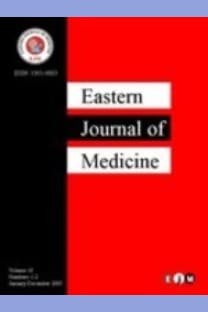Choroidal Thickness and Serum Asymmetric Dimethylarginine Levels in Patients with Systemic Sclerosis
Choroidal Thickness and Serum Asymmetric Dimethylarginine Levels in Patients with Systemic Sclerosis
___
- 1. Singh D, Parihar AK, Patel S, et al. Scleroderma: An insight into causes, pathogenesis and treatment strategies. Pathophysiology 2019; 26: 103-114.
- 2. Ingegnoli F, Ughi N, Mihai C. Update on the epidemiology, risk factors, and disease outcomes of systemic sclerosis. Best Pract Res Clin Rheumatol 2018; 32: 223-240.
- 3. Kreps EO, Carton C, Cutolo M, et al. Ocular involvement in systemic sclerosis: A systematic literature review, it's not all scleroderma that meets the eye. Semin Arthritis Rheum 2019; 49: 119-125.
- 4. Fett N. Scleroderma: nomenclature, etiology, pathogenesis, prognosis, and treatments: facts and controversies. Clin Dermatol 2013; 31: 432-437.
- 5. Tailor R, Gupta A, Herrick A, et al. Ocular manifestations of scleroderma. Surv Ophthalmol 2009; 54: 292-304.
- 6. Chan A, Duker JS, Ko TH, et al. Normal macular thickness measurements in healthy eyes using Stratus optical coherence tomography. Arch Ophthalmol 2006; 124: 193-198.
- 7. Brinkmann SJ, de Boer MC, Buijs N, et al. Asymmetric dimethylarginine and critical illness. Curr Opin Clin Nutr Metab Care 2014; 17: 90-97.
- 8. Preliminary criteria for the classification of systemic sclerosis (scleroderma). Subcommittee for scleroderma criteria of the American Rheumatism Association Diagnostic and Therapeutic Criteria Committee. Arthritis Rheum 1980; 23: 581-590.
- 9. Tan KA, Gupta P, Agarwal A, et al. State of science: Choroidal thickness and systemic health. Surv Ophthalmol 2016; 61: 566-581.
- 10. Ingegnoli F, Gualtierotti R, Pierro L, et al. Choroidal impairment and macular thinning in patients with systemic sclerosis: the acute study. Microvasc Res 2015; 97: 31-36.
- 11. Coşkun E, Zengin O, Kenan S, et al. Evaluation of choroidal thickness in patients with scleroderma. Eye (Lond) 2016; 30: 588-592.
- 12. Esen E, Tas DA, Sizmaz S, et al. Evaluating choroidal characteristics in systemic sclerosis using enhanced depth imaging optical coherence tomography. Ocul Immunol Inflamm 2017; 25: 356-362.
- 13. Aydin E, Atik S, Koc F, et al. Choroidal and central foveal thickness in patients with scleroderma and its systemic associations. Clin Exp Optom 2017; 100: 656-662.
- 14. Dooley A, Gao B, Bradley N, et al. Abnormal nitric oxide metabolism in systemic sclerosis: increased levels of nitrated proteins and asymmetric dimethylarginine. Rheumatology (Oxford) 2006; 45: 676-684.
- 15. Németh B, Ajtay Z, Hejjel L, et al. The issue of plasma asymmetric dimethylarginine reference range - a systematic review and meta-analysis. PLoS One. 2017; 12: e0177493.
- 16. Wieczór AM, Wieczór R, Kulwas A, et al. Asymmetric dimethylarginine and angiogenesis: biological significance. Int Angiol 2018; 37: 431-436.
- 17. Zhou S, Zhu Q, Li X, et al. Asymmetric dimethylarginine and all-cause mortality: a systematic review and meta-analysis. Sci Rep 2017; 7: 44692.
- 18. Tain YL, Hsu CN. Toxic dimethylarginines: asymmetric dimethylarginine (ADMA) and symmetric dimethylarginine (SDMA). Toxins (Basel) 2017; 9: 92.
- 19. Zhang L, Wan YN, Zhao JH, Wang YJ, Wang YX, Yan JW, Huang XL, Wang J. The association between systemic sclerosis, arginine and asymmetric dimethylarginine. Inflammation 2015; 38: 218-223.
- 20. Blaise S, Maas R, Trocme C, et al. Correlation of biomarkers of endothelium dysfunction and matrix remodeling in patients with systemic sclerosis. J Rheumatol 2009; 36: 984-988.
- 21. Dağ Ş, Budulgan M, Dilek B, et al. Relation of asymmetric dimethylarginine and cardiac involvement in systemıc sclerosis. ActaReumatol Port 2014; 39: 228-235.
- 22. Dimitroulas T, Giannakoulas G, Sfetsios T, et al. Asymmetrical dimethylarginine in systemic sclerosis-related pulmonary arterial hypertension. Rheumatology (Oxford). 2008; 47: 1682-1685.
- 23. Silva I, Teixeira A, Oliveira J, et al. Endothelial dysfunction and nailfoldvideocapillaroscopy pattern as predictors of digital ulcers in systemic sclerosis: a cohort study and review of the literature. Clin Rev Allergy Immunol 2015; 49: 240-252.
- ISSN: 1301-0883
- Yayın Aralığı: 4
- Başlangıç: 1996
- Yayıncı: ERBİL KARAMAN
Buket Mermit ÇİLİNGİR, Selami EKİN, Hanifi YILIDIZ, Aysel SÜNNETÇİOĞLU, Hülya GÜBATAR
Relationship between SUVmax in F-18 FDG PET/CT and serum YKL-40 levels in Breast Cancer
Ebru Orsal İBİŞOĞLU, Arif Kürşat AYAN, Zeynep AKAR, Engin ŞEBİN
Ayşegul BESTEL, Aybeniz Civan KAHVE, Merve Aldıkaçtıoğlu TALMAÇ, Pinar Yalçın BAHAT, Zübeyde AYTUFAN, İbrahim POLAT, İsmail ÖZDEMİR
Şükriye İlkay GÜNER, Selver KARAASLAN, Savaş GÜNER, Reyhan ORHUN, Gül ULAY
Diagnostic and Prognostic Value of Serum NT-ProBNP in the Diagnosis of Neonatal Sepsis
İbrahim DEĞER, Abdullah CEYLAN
X-ray Exposure Reduces the Number of Hippocampal Pyramidal Neurons in Offspring Rats
Ersin İBİŞOĞLU, Hacı Murat GÜNEŞ, Filiz KIZILIRMAK, Beytullah ÇAKAL, Oguz KARACA, Mehmet Onur OMAYGENÇ, Ekrem GÜLER, Gültekin Günhan DEMİR, Fatih Erkam OLGUN, Ümeyir SAVUR, Deniz Dilan NAKİ, Bilal BOzTOSUN
Effectiveness of Pulmonary Rehabilitation in Secondary Spontaneous Pneumothorax Patients
Halil ÇİFTÇİ, Ömer GEZGİNASLAN
Relationship Between Inflammatory Parameter and Mortality in Intensive Care Patients with COVID-19
Necla DERELİ, Münire BABAYİĞİT, Filiz KOÇ, Özlem ÖZBEK, Gökhan YILDIZ, Merve KARAŞAHİN, Özge GÜRSÖZLÜ, Nur Sena ÇAKAR
Sinan OĞUZKAYA, Mehmet HALICI, İbrahim Halil KAFADAR, İbrahim KARAMAN
